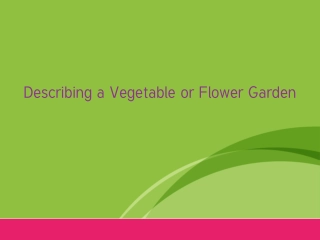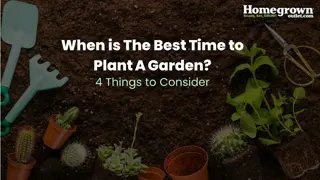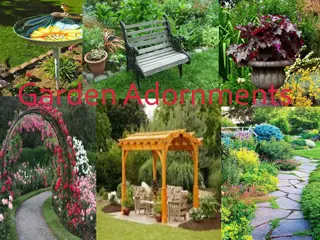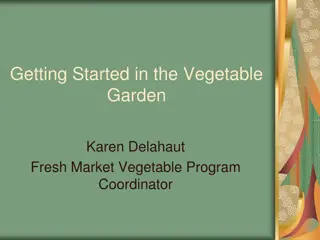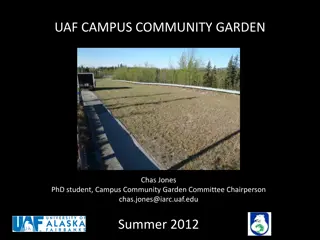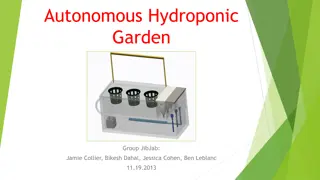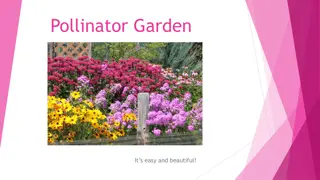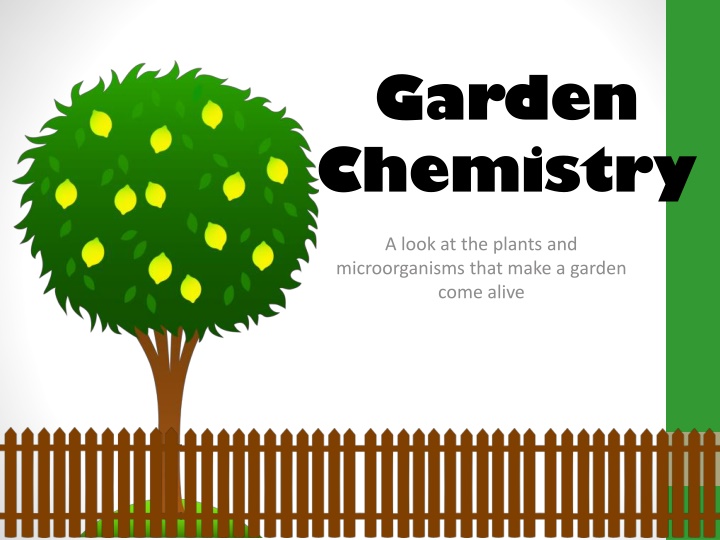
Uncovering the Intricate World of Garden Chemistry and Soil Ecosystems
Explore the fascinating dynamics of garden chemistry, symbiotic relationships, and the diverse microorganisms in soil that play vital roles in maintaining a thriving garden. Discover the roles of producers, consumers, decomposers, and more in this enlightening journey through the interconnectedness of plant life and soil organisms.
Download Presentation

Please find below an Image/Link to download the presentation.
The content on the website is provided AS IS for your information and personal use only. It may not be sold, licensed, or shared on other websites without obtaining consent from the author. If you encounter any issues during the download, it is possible that the publisher has removed the file from their server.
You are allowed to download the files provided on this website for personal or commercial use, subject to the condition that they are used lawfully. All files are the property of their respective owners.
The content on the website is provided AS IS for your information and personal use only. It may not be sold, licensed, or shared on other websites without obtaining consent from the author.
E N D
Presentation Transcript
Garden Chemistry A look at the plants and microorganisms that make a garden come alive
Soil is More Than Dirt! https://www.youtube.com/watch?v=VuHznslr8aI
Everyone has a job Producer: an organism that can create its own food (energy) Consumer: obtains energy by feeding on other organisms Decomposer: breaks down dead or decaying things Pathogen: anything that can produce disease Parasite: lives on a host and derives nutrients at the host s expense Host: harbors a parasite Predator: lives by eating others Prey: killed for food
Everyone is in a relationship Symbiosis: a close and often long-term interaction between different biological species Commensalism - relationships between two organisms where one organism benefits from the other without affecting it Mutualism: a relationship in which each individual benefits from the activity of the other Parasitism - relationships between species, where one species, the parasite, benefits at the expense of the other, the host
Little critters Lots of things live in soil! Bacteria Protozoa Fungi Nematodes Arthropods Some are beneficial while others can be harmful
Bacteria 1 teaspoon of soil can contain 100 million to 1 billion bacteria Bacteria can be decomposers, mutualistic, or pathogens. They help improve soil quality by: decomposing organic matter keeping nutrients in the root zone enhancing soil structure competing with disease-causing organisms filtering/degrading pollutants in the soil Rhizobia are bacteria that form nodules on the roots of host plants and give the plant nitrogen in exchange for essential minerals and sugars. What is this called?
Fungi What are some examples of fungi? Mushrooms, mold, and yeast Fungi can be decomposers, mutualists, or pathogens Fungi grow as long strands called hyphae and push their way between soil particles, rocks, and roots. Mycorrhizae are fungi that help plants increase uptake of water and nutrients and enhances a plant s ability to tolerate stress in exchange for essential sugars and compounds to fuel fungal growth. This is called a
Protozoa These are microscopic, single-celled organisms that eat bacteria. As they eat bacteria, excess nitrogen is released that the plant can use. Protozoa also prevent some pathogens from growing on the plant roots. They are a food source for nematodes. This means that protozoa are _______ and nematodes are ______________
Nematodes These are small, un-segmented round worms. They live in the water found in soil. Nematodes can be beneficial They spread bacteria and fungi through the soil as they move around. They can also prevent root access for root-feeding nematodes. They can also cause harm Some nematodes feed on plant roots. This makes them ______________
Arthropods Insects, spiders, and mites Most live in the upper three inches of soil and: create structure by burrowing and depositing fecal pellets control disease causing organisms stimulate microbial activity enhance decomposition by shredding organic matter and mixing soil The role of arthropods in the soil is _____________
We Can Impact Soil Organisms Add organic matter like mulch or compost to the soil to feed the organisms. Remember to water! Soil organisms like damp environments, but not soggy. Too much water can be just as harmful as too little. Only apply pesticide if absolutely necessary. Some of these products can be harmful to some soil organisms.
Soil nutrients Plants need essential nutrients Most soils contain 14 of the 17 nutrients needed! Macronutrients: elements used in large quantities: Carbon C Hydrogen H Oxygen O Nitrogen N Phosphorus P Potassium K Calcium Ca Magnesium Mg Sulfur S Micronutrients: elements used in small quantities: Boron Copper Chlorine Iron Manganese Molybdenum Mo Zinc B Cu Cl Fe Mn Zn
Quick quiz! Put the following elements in their proper category: Macronutrients Micronutrients
Deficiency When plants don t get enough of their vital nutrients, they will experience poor growth and can develop disease. Though you can often tell what a plant is missing just by looking at it, some deficiencies may cause similar symptoms. For more symptoms of nutrient deficiencies, check out http://extension.arizona.edu/sites/extension.arizona.edu/files/pubs/az1106.pdf
Soil plays a big part Organic matter is the best way to provide nutrients for the soil and prevent plant deficiencies.
Soil plays a big part Before a nutrient can be used by a plant, it must be dissolved into the soil solution. Most minerals and nutrients are more soluble in acidic soils, which means they are more available when the pH is low.
pH A scale to measure if a substance is acidic or basic 0-6 = Acidic 7 = Neutral 8-14 = Basic (or alakaline) It tells the concentration of hydrogen ions (H+) in the soil.
Practice! We can calculate this by using the following formula: pH = - log [H+] If the H+concentration is 0.0001 M/l, what is the pH? Answer: 4 Let s see the work - log (.0001) = 4 If the H+concentration is 0.00005 M/l, what is the pH? Answer: 4.3
Acidic pH: 0-6 What are some acidic things? Lemons: 2.5 Tomatoes: 4.5 Potatoes: 5.6
Neutral pH: 6.5-7.5 What are things that might be neutral? Saliva: 6.6-7.3 Blood: 7.3 Shrimp: 7
Basic pH: 8-14 What are some things with a basic pH? Eggs: 7.8 Sea water: 8.2 Ammona: 11
Certain plants prefer acidic soils. If the soil becomes slightly alkaline (a little basic) this can interfere with availability of nutrients. Ex: Pin Oak trees in central New York can t get enough iron if the pH is elevated to 7.4-7.8
What if we dont want acidic soil? Soil can become acidic due to: Rainwater washing away basic ions like Ca, Mg, K, and Na, leaving lots of leftover H+ ions Byproducts of decaying matter and root respiration
Just add a little lime Lime is a limestone compound that raises soil pH Replaces H+ ions Provides Ca and Mg Makes any P added to the soil more available for plants
Digging Deeper! List 3 of the roles of soil organisms. List 3 relationships soil organisms have with one another. What are the 2 classes of nutrients? How can nutrients be added to the soil? Do soils prefer acidic or basic soil?



